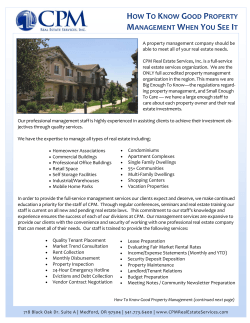
Document 238596
Biomass pelleting By Arthur A. Vom Hofe Area manager - CPM Europe - What is pelleting? - Who is CPM? - What is so special about CPM? - Biomass applications - Bagasse pelleting 1 What is pelleting? •A Pelletmill compresses mealy or powdery materials into firm, uniformly shaped granules. What is pelleting? Pelleting is a process: • Bin: To buffer product. • Feeder: To dose product. • Conditioner: To prepare the product by mixing with liquid(s) and/or steam. • Pellet Mill: To form pellets • Cooler: To cool (and dry) the pellets. Sieve: To separate fines from pellets. 2 Why pelleting? • Minimizes problems of reclaiming or disposing of dust, powders, residues or other hard to handle materials. • Reduces cost for shipping, storage and handling. • Densifies waste materials. • Converts combustible energy resources into more efficiently consumed, cleaner burning pelleted fuel California Pellet Mill & Roskamp / Champion • is the world leading designer and manufacturer of pelleting equipment, offering a complete line of pellet mills, conditioning systems, coolers, crumblers, coaters, feed cleaning systems and pellet dies. • Designs and manufactures a broad range of particle size reduction machinery. The product line includes roller mills, hammer mills, shredders and crushers, and also flaking mills, oat hullers, steam chambers, rotary feeders. 3 California Pellet Mills Up to 50% of all pellet mills in the world are made by CPM What is so special about the CPM pellet mill? 4 It is a gear box! • high efficient power transmission • compact safe design • high production-line availability factor Efficiency • Do you realize that a gear has an over 11% higher efficiency than a two stage V-belt drive? • Do you realize the savings? • Do you realize what a high efficiency transmission means to the process and machine user-friendliness • Do you realize the savings? 5 Efficiency Example: • • • • • Motor 225 kW 20 Hours per day 6 Days per week 6000 Hours/Year 50 weeks per year Energy rate Euro 0,08/kWH. SAVING: 6000 Hours/Year x 250 kW x Euro 0,08/kWH x 11% saving = 11.880 Euro/Year It is a “ring” die • Less sensitive to moisture content • High efficiency • Users friendly 6 It has two rollers • Better grip through small nip angle • High efficiency • Low wear costs Compact safe design • • • • • Space requirement Dust insensitive Static electricity fire/explosion danger safety 7 high production-line availability factor • Less sensitive for Overload/stall • Low Maintenance The CPM pelletmill features: • Pellet mill and direct coupled drive motor on common base plate. • Reliable shear-pin protection. • Continuous lubrication during operation. • Easy die mounting. • Two rolls • User-friendly design. 8 BIO MASS APPLICATIONS • WOOD • SEWAGE SLUDGE • RDF • COAL • SUNFLOWER HULLS • BAGASSE • PEAT • MEAT AND BONE MEAL • OTHERS BIOMASS APPLICATIONS Fuel values, equivalent BTU basis 9 Why bagasse pelleting? Pellets are: Dust free: reducing dust explosion potential minimizing particle emission Uniform: more efficient control of combustion Why bagasse pelleting? Pellets are: Free flowing: facilitating material handling and rate of flow control Increased bulk density: more BTU’s per volume unit economies storage and transportation 10 Why bagasse pelleting? 1) Fuel for Burning •ø 6 / 8 mm: household stoves •ø 8 / 18 mm: Industrial •Energy level: 4,8 – 5 kWh/kg •Compared to Oil: 1 ltr oil = 2,4 kg bagasse pellets 2) Feed ingredient TYPE OF RAW MATERIALS • Natural Bagasse (After extraction) • Hydrolyzed Bagasse (Steam treated) 11 PREPARATION PRIOR TO PELLETIZING Drying: •Product will be dried down to 1012% moisture •Energy input around 1 MWh/t •Dryer fired with waste bagasse Particle size control SIEVING: • Use bigger sizes for burning GRINDING: •Usually ø 8 mm hammermill screen •Energy input typically 12 – 20kWh/t 12 PREPARATION PRIOR TO PELLETIZING Addition of binding agent • Molasses • Other materials (spent grains, starch etc) • Added before hammermill or before conditioning. PREPARATION PRIOR TO PELLETIZING Ripening time •Soaking time for maximum absorbability •Depending on site conditions with ripening kettle or separate bin 13 PREPARATION PRIOR TO PELLETIZING Addition of water / steam •Addition of surface moisture to lubricate and bind the particles. PELLETIZING SYSTEMS Type of pellet mills for bagasse •Special range of pellet mills made suitable for biomass pelleting •Dies have been designed to suit the tough pelleting conditions •Rollers are developed to cope with the high loads • Special forced feeder design suitable for low bulk density input materials 14 PELLETIZING SYSTEMS Model Century pellet mills •2016-2 with 90 kW •Capacity 1 – 1,5 t/h •Die Area 750 cm² PELLETIZING SYSTEMS Model 7700 pellet mills •7722-4 with 160 kW •Capacity 2 – 3 t/h •Die Area 1700 cm² 15 PELLETIZING SYSTEMS Model 7900 pellet mills •7930-4 with 250 kW •Capacity 4 – 5 t/h •Die Area 2250 cm² DIES •Integrated stiffening ring •High resistant steel •Total thickness adjusted •Open area guidelines (around 39%) 16 Rolls •Special bearings (spherical) •Narrow track to reduce loads •Reduced bearing loads = lower roll temperatures •Reduced roll temperatures = longer bearing life •Reduced roll temperatures = less degeneration of grease Energy consumption Transport Grinding 5 Kw/t 15 kw/t Pelleting Cooling Various Total 50 Kw/t 2,5 kw/t 2,5 kw/t +/- 75 Kw/t 17 Reasons for waste management and recycling Increased prices for landfill. Increased energy/fuel prices. Increased taxes on fossil fuels. Increased prices for products made of recycled materials. • Increased prices for new basic ingredients. • • • • CPM / Europe.b.v. Amsterdam / the Netherlands Your partner for advice Your partner for making Profit Your partner for knowledge Your partner for the future 18
© Copyright 2025















